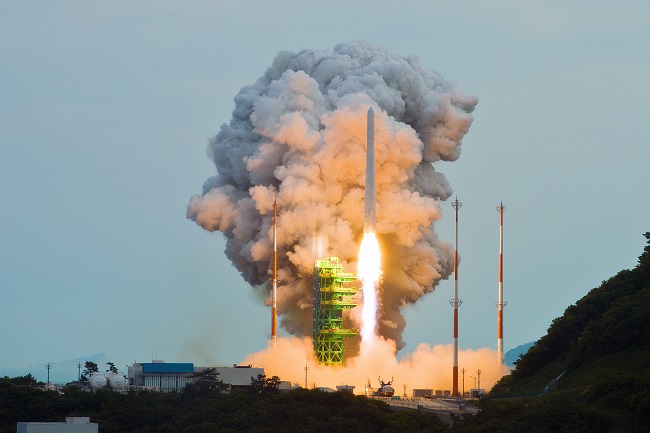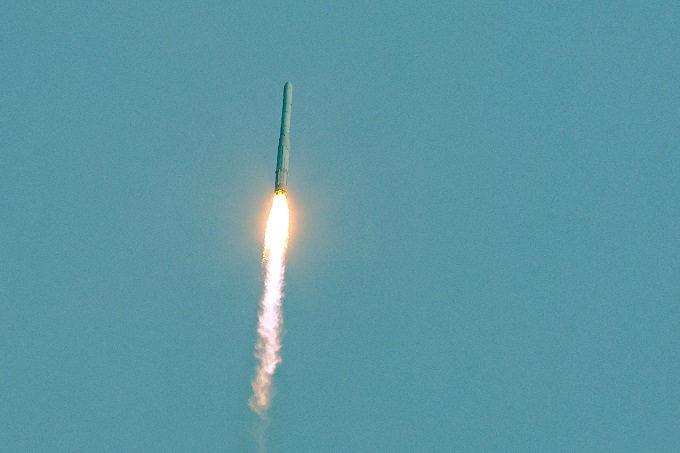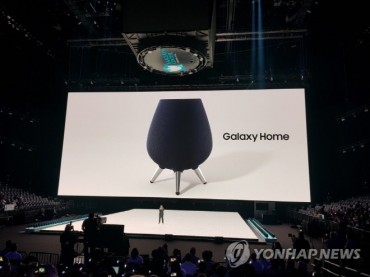
South Korea’s homegrown space rocket Nuri blasts off from Naro Space Center in Goheung, South Jeolla Province, on May 25, 2023. (Yonhap)
SEOUL, May 25 (Korea Bizwire) — South Korea’s homegrown space rocket successfully made its flight to put eight payload satellites into orbit Thursday, demonstrating the country’s status as one of the seven space powerhouses that developed a space launch vehicle that can carry a more than 1-ton satellite.
Nuri blasted off from the Naro Space Center in the country’s southern coastal village of Goheung at 6:24 p.m. and finished its flight sequence in about 20 minutes after deploying satellites into orbit 550 kilometers above Earth as planned.
The Ministry of Science and ICT said Nuri’s launch succeeded.
“Following the success of the second launch of Nuri last year and the third launch today, we have confirmed the flight performance of Nuri, not only confirming the reliability of Nuri, but also confirming our potential for launch services for various satellite operations and space exploration,” Science Minister Lee Jong-ho said in a briefing.
President Yoon Suk Yeol lauded the successful launch of space rocket Nuri, saying it is a “splendid feat” marking South Korea’s entry into the Group of Seven space powers.
Its main payload, the NEXTSAT-2, or South Korea’s second next-generation small satellite, reached its orbit, but whether one of the seven microsatellites onboard Nuri was deployed normally from the rocket remains unknown, according to the science ministry.
Six others are on track, it added.

South Korea’s homegrown space rocket Nuri blasts off from the Naro Space Center in Goheung, South Jeolla Province, on May 25, 2023. (Yonhap)
The latest success of Nuri verified South Korea’s capability to operate a space vehicle to carry payload satellites into target orbit and cemented its status as a space power since its first science observation rocket in 1993.
“Now South Korea has its own rocket and is able to put its own satellites into orbit on our soil,” said Prof. Kwon Se-jin from the department of aerospace engineering at the Korea Advanced Institute of Science and Technology (KAIST).
“We can have our foreign customers in the coming future and carry their satellites to space like other space powers, such as the United States, do.”
After several failures over two decades, South Korea has started the Nuri project, or the Korean Space Launch Vehicle-II (KSLV-II) project, investing nearly 2 trillion won (US$1.52 billion), to build the three-stage rocket with homegrown space technologies — from design and manufacturing to testing and launching.
In 2021, the rocket successfully flew to its target altitude of 700 kilometers but failed to put a dummy satellite into orbit, as its third-stage engine burned out earlier than expected.
On its second attempt in 2022, Nuri successfully completed its flight sequence, and deployed a dummy and performance verification satellite at the target altitude of 700 kilometers as planned.
The feat helped South Korea become the seventh country in the world to develop a space launch vehicle that can carry a more than 1-ton satellite, after Russia, the U.S., France, China, Japan and India.
Since then, South Korea has moved one step further, as Nuri was assigned to carry eight practical satellites that have their own respective missions in space on its third flight.
“The two previous launches were focused on developing a homegrown rocket, but the third one is aimed at carrying payloads to a targeted orbit,” Lee Sang-ryool, president of the Korea Aerospace Research Institute (KARI), said.
Designed and developed by KAIST, the 180-kilogram NEXTSAT-2 will demonstrate X-band radar technology and measure space radiation on a dawn-dusk orbit for the next two years.
Four microsatellites developed by the Korea Astronomy and Space Science Institute, codenamed SNIPE, and located beneath the NEXTSAT-2, will identify temporal and spatial variations of small scale plasma structures in the ionosphere and magnetosphere.
Data from SNIPE will be shared with the U.S. National Aeronautics and Space Administration (NASA).
The three others are the JAC by Korean engineering company Justek Inc., the LUMIR-T1 by local space firm Lumir Inc. and the KSAT3U by startup Kairospace Co.

South Korea’s homegrown space rocket Nuri is erected for launch at Naro Space Center in Goheung, 328 kilometers south of Seoul, on May 25, 2023, in this photo provided by the Korea Aerospace Research Institute.
South Korea plans to conduct three additional Nuri rocket launches by 2027 as part of efforts to further upgrade the country’s space rocket program.
For the upgrading project, Hanwha Aerospace Co., an aerospace business unit of chemical-to-financial conglomerate Hanwha Group, will lead the mission with KARI as part of the Korean government’s long-term plan to transfer the space technologies to the private sector.
At the same time, the South Korean government has launched a separate space project, named KSLV-III, to develop a next-generation rocket worth 2.1 trillion won for the next 10 years.
The project is aimed at developing a two-stage rocket using multi-stage combustion technology and sending Korean-made lunar landers by 2032.
Following the 2022 success, South Korea announced a road map for a “future space economy, helping transform the nation into a “space economy” power.
As part of the plan, the government will establish an aerospace agency similar to NASA, assuming full charge of the state-led space programs and aeronautics research.
The organization is expected to be launched by the end of this year.
(Yonhap)






